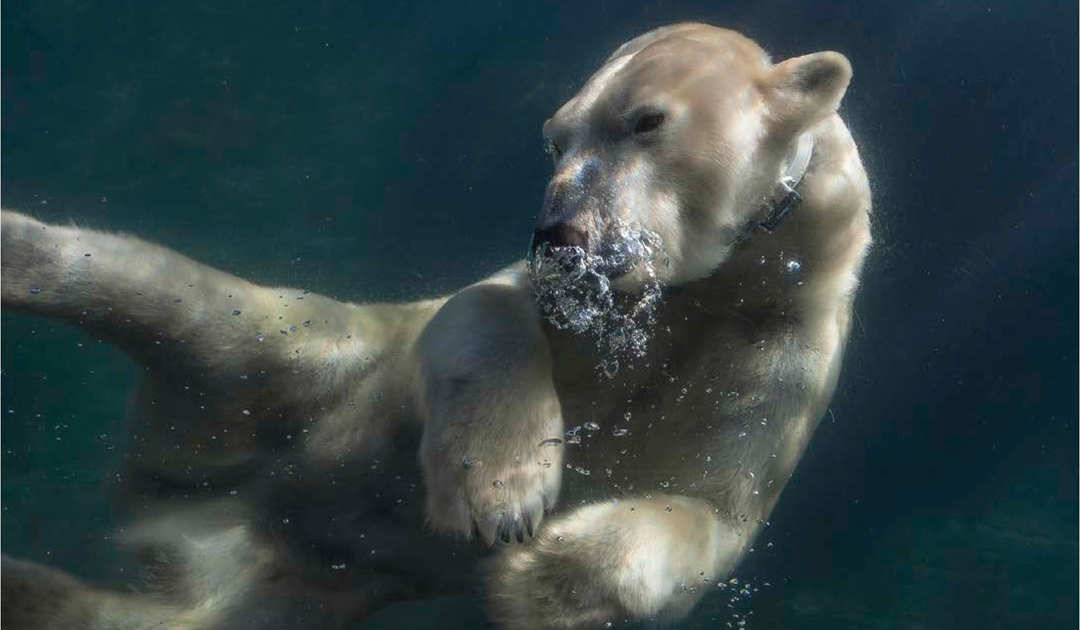
An emblematic animal of the Far North, the polar bear is regularly the subject of scientific research. But it’s not easy to study the King of the Arctic in its natural environment, and this creates a number of gaps in our understanding of the species and, consequently, in our conservation policies. To find out more about this polar plantigrade, researchers sometimes turn to polar bears in zoos.
How do polar bears hear? To what extent can the noise produced by mining or oil operations disturb them? In a melting Arctic, where will polar bears choose to make their dens? What additional energy expenditure will be required to find prey or reproduce? How can we measure the metabolism of polar bears and their energy expenditure in activities such as walking or swimming? How reliable are drones for measuring body mass?
These are just some of the questions that scientists are asking to better understand the King of the Arctic and take action to conserve him. But finding answers isn’t easy. Polar bears evolve in a vast territory that is difficult to access and requires extensive and often costly logistics, making some research extremely complicated, if not impossible, in the field. What’s more, any examination of a polar bear in the wild requires the animal to be put to sleep beforehand using an anaesthetic shot from a helicopter. Here again, the technique is costly, even dangerous, and hardly allows regular sampling of the same subject. Besides, it’s difficult to carry out examinations or take blood or tissue samples from animals outside the summer period. These difficulties in the field have led to gaps in our knowledge of polar bears.
In an attempt to overcome this problem, a number of research projects are based, in whole or in part, on work carried out with polar bears in zoos. Over the past ten years, some 100 peer-reviewed publications have been published, according to Dr. G. B. B., who is also a member of the Board of Directors. Erin Curry, Director of the Polar Bear Signature Project at the Cincinnati Zoo and Botanical Garden’s Center for Endangered Wildlife Conservation and Research, and Co-Chair of the Polar Bear Research Council. “Polar bears in zoos offer scientists valuable opportunities to learn about the physiology and behavior of this species.”, she notes in an email to Polar Journal AG. “Because longitudinal samples are impossible to collect from wild bears, zoo bears allow for the characterization of hormones across seasons and ages, generating a wealth of reference data useful for studying the impacts of a changing environment on wild bears.”

From reproduction to nutrition, from the validation of new tracking technologies to a better understanding and modeling of the polar bear’s physiological ecology, the research topics are vast and touch every field. But how is polar bear research organized in zoos?
Encouraging and coordinating
Formed in 2018 by a group of scientists and veterinarians working both in zoos and field settings, the Polar Bear Research Council (PBRC) encourages North American zoos to participate in studies focused on scientific questions that researchers can’t answer by conducting field studies. The Council also contributes to the coordination of research.
In concrete terms, a research team fills in a form detailing its study project, which will be reviewed by the PBRC, which is composed of several teams of experts across various disciplines. After providing feedback and recommanding whether or not zoos should consider participating in the project, they communicate the opportunity to all zoos holding polar bears to connect researchers with appropriate facilities.

But the PBRC’s activities don’t stop there. “The PBRC also maintains a listserv for polar bear scientists and other professionals to communicate and share knowledge, a database of publications and ongoing projects, an updated Masterplan, and encourages participation in international meetings such as the International Association for Bear Research and Management conference in Edmonton, Alberta this September”, mentions Dr. Curry.
In 2023, PBRC members joined their European colleagues to help them complete their “Polar Bear Research Prospectus” “a document designed to guide research on polar bears in zoos and aquariums in Europe and equivalent to the PBCR “Masterplan”, published every two to five years. “Future projects include creating standardized sampling and necropsy protocols for everyone working with polar bears to be collecting biological data in the same way so it is comparable in future investigations.”, completes Dr. Curry.

Strict regulations
Conducting research on polar bears in a zoo is strictly regulated, as is the housing of these animals in this type of facility. Because in order to house a polar bear, you have to show your credentials.
Unless they were born there, polar bears in zoos are generally orphan cubs placed by government authorities. Any zoo or aquarium wishing to house a polar bear must obtain a permit and meet strict requirements regarding veterinary care, facility requirements and food and water quality for these animals classified as marine mammals.
In North America, the Association of Zoos and Aquariums (AZA) and the Canadian Association of Zoos and Aquariums (CAZA) are the organizations responsible for accrediting facilities housing polar bears. In Europe, the EAZA (European Association of Zoos and Aquariums) manages polar bears in European zoos via the Bear Taxonomic Advisory Group (TAG).
Mirjana Binggeli, Polar Journal AG
More on the subject





